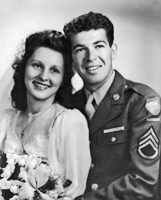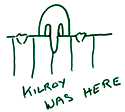The Stamford Historical Society Presents
Pride and Patriotism: Stamford’s Role in World War II
Online Edition
The Interviews
Phil Lodato
Phil Lodato was drafted into the Army in 1942. He served in a weapons battalion in the machine gun section of the 100th division, 4th platoon, 399th Combat Infantry Company. He had reached the rank of Staff Sergeant before being shipped to France in 1944. He was captured by SS troops in the Vosges Mountains and remained a prisoner in German hands until his camp, 30 miles south of Berlin, was liberated by the Russians.
 I was working at Yale & Towne before I was drafted. I only went to the ninth grade.
I joined the service in 1942. I was drafted. In South and North Carolina I had training in a weapons battalion, machine gun section in army…100th division, 4th platoon, 3rd battalion. I stayed there for a few years training, then I stayed back to train other guys…our outfit went over as a unit…I was in weapons platoon…in 1944 we went over. We landed in France at end of June 1944. Bulge was December 19, so we landed maybe 6 months before that. We were in combat before capture. I lost all the gunners I trained with and had to get new recruits…I was in lots of skirmishes.
I was working at Yale & Towne before I was drafted. I only went to the ninth grade.
I joined the service in 1942. I was drafted. In South and North Carolina I had training in a weapons battalion, machine gun section in army…100th division, 4th platoon, 3rd battalion. I stayed there for a few years training, then I stayed back to train other guys…our outfit went over as a unit…I was in weapons platoon…in 1944 we went over. We landed in France at end of June 1944. Bulge was December 19, so we landed maybe 6 months before that. We were in combat before capture. I lost all the gunners I trained with and had to get new recruits…I was in lots of skirmishes.
We went through some battles I lost a few guys…we were going over the Vosges Mountains in France, there was snow on the ground and we had full packs. We finally came to our designation where the Captain said that we were going to camp for the night. That night we heard rumbling…I had 12 men and two machine guns we had set up…we heard what we thought were tanks rumbling and so everybody dug in. My guys dug in very deep…with tanks you need to be deep or they will squash you…next morning we found out they weren’t tanks but three flak wagons. Flak wagons had small cannon, 20 mm shells. When its shell hits something it spreads out and kills all in its path. The next morning the Germans flak wagons opened fire on us. One of my machine guns was no more than 500 yards away, the one on the left flank was a bit away but we were very close. They opened up on us with their machine guns…guns fired and fired. One of our machine guns fired so much that the barrel got hot and it stopped firing. Usually we were taught to fire in spurts but one of our guys kept firing because of nerves. The Germans overran our position and captured my two guns, my 12 men. In the 1st platoon the Germans killed every man in it…killed 50 to 60 men. I was a staff sergeant.
They took us prisoners. They took 28 men total, a majority of our men were killed because of the flak wagons shooting the exploding projectiles that exploded on impact. Many of the guys were moaning, many wounded. We went down below the hill into a natural ravine. I thought this will be it…they are going to shoot us. They were young SS troops, merciless. They looked at us and we felt we would be shot, but they put us on a truck and drove us about 3 miles to a barn. Before that they interviewed some of the NCOs and interrogated us…lots of questions. They did not torture us…we were so scared we were talking, but they knew everything anyway, they knew who we were. We went back to the barn. We were told we would go to a camp. We went to the barn and from then on we were on march. We were put in a formation, 100 to 200 prisoners on the march. The RAF planes would come down and strafe us because they thought we were Germans. We were never marked. Then they put us in a prison camp in Limburg, Germany, big prison camp. We were starving and cold. It was a railroad yard, the RAF came over and bombed it. It felt like the floor of the concrete building in which we were sleeping jumped 10 feet. It was a concrete factory building. We were sleeping on the floor. To keep warm, three guys had to sleep together, one in the middle. They weren’t feeding us either. They gave us a cup of grass soup. They starved us. These camps were run by older German guys. Life was miserable, we were bombed and strafed by our own people. Planes came over and bombed us. I lost one guy who poked his head out and got killed by shrapnel…. They had barracks, two barracks away the bombs hit one and killed 52 officers. They were Italians, English and Americans. From there they put us in boxcars…the RAF still strafed us and made life miserable.
I was captured December 6, 1944. When I got to a decent camp, the climate was different and cold, but the food was in Red Cross boxes. Our final camp was located 30 miles from Berlin. Every night we could hear bombs like thunder. I was two months traveling from Limburg to the final camp under constant fire. The day at the camp was ok. We didn’t have to do anything. They fed us, for the last 4 months with Red Cross boxes…we were in bunks…still no heat but it was nice, livable. We were constantly traveling before that. There were so many prisoners…the boxcars were all filled up. At one point Germans were shooting prisoners. I spent the first few months terribly but the last four in a camp that was well established. Although there was no heat…frost was six inches thick…a lot of guys lost their feet. Before that last camp we would pick up turnips from the fields…after food was better. At this camp we had Russians, Italians, English and US, but the Russians were mistreated. I got pictures of one guy that was all skin and bones…like a skeleton. They were dying like flies in that camp…they didn’t get any food. And the Germans hated them. I stayed there 6 months and later on we heard bombs from Berlin, heavy bombs. The Germans told us they were going to leave…Americans coming in etc.
I wrote it down in a diary…it was toward the end of the war, around mid-April. The Russians came in…with tanks and destroyed everything. The Russians liberated us. The Russian prisoners were all sickly, but they jumped on the tanks hugged and kissed the driver, happy to be liberated. After the Russians came in Americans, English and Italians were to be contacted so we could be picked up. We stayed there two weeks. Americans came over with 20 trucks and took us to Belgium. We stayed there for a while. We got good food. Then we went to a point of debarkation to go to the US. There must have been 50,000 guys there. From there I went home. I went to Lake Placid, New York for two weeks, they interrogated you, went through lots of paperwork then were discharged.
I was still shaken up from the bombs. When cars backfired I would put my head down. I was shell-shocked, it lasted several years.
Photo Courtesy Phil Lodato
Battle of the Bulge
 Introduction
Introduction
Veterans
Battles
Stamford Service Rolls
Homefront
Exhibit Photos
Opening Day

